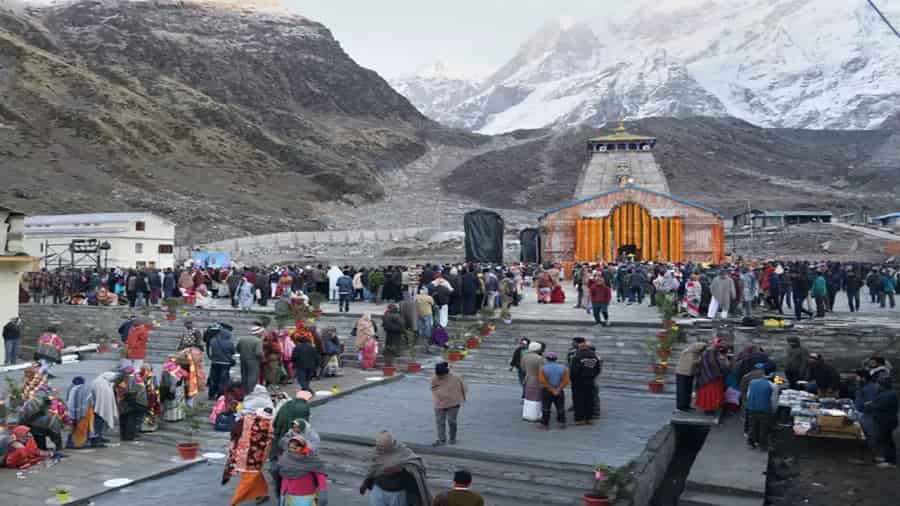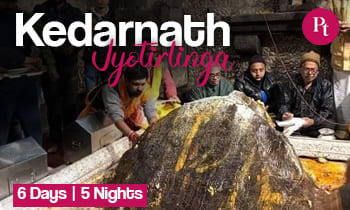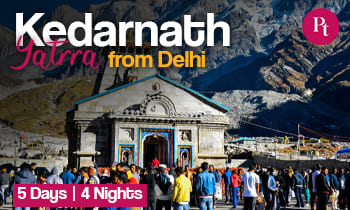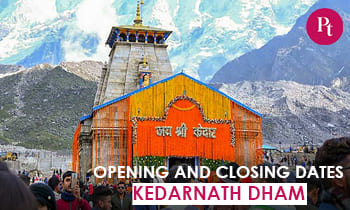Kedarnath Temple, nestled in the majestic Himalayas of Uttarakhand, India, is one of the holiest Hindu shrines dedicated to Lord Shiva. This ancient temple holds immense significance not only for its religious importance but also for its remarkable architectural beauty. In this comprehensive guide, we will delve into the significance of Kedarnath Temple, explore its architectural marvels, take a peek inside its sacred sanctum, and provide you with essential information about its timings and accessibility.

Significance of Kedarnath Temple
Spiritual Significance
Kedarnath is one of the twelve Jyotirlingas (sacred shrines of Lord Shiva) and is considered to be the most remote and challenging to reach among them. The temple’s spiritual significance lies in the belief that Lord Shiva himself resides here in the form of a lingam (an abstract representation of the divine). Pilgrims visit Kedarnath to seek Lord Shiva’s blessings and to attain spiritual enlightenment.
Mythological Importance
The origins of Kedarnath Temple are steeped in Hindu mythology. It is believed that after the Kurukshetra War in the Mahabharata, the Pandavas sought forgiveness for their sins from Lord Shiva. However, Lord Shiva eluded them and assumed the form of a bull. When the Pandavas discovered him, they tried to hold onto his hump, and in the process, the bull’s body parts scattered across different locations. Kedarnath is where Lord Shiva’s hump is said to have appeared, and the temple was built to honor this divine event.
Char Dham Yatra
Kedarnath is an integral part of the Char Dham Yatra, a pilgrimage circuit that includes Badrinath, Yamunotri, Gangotri, and Kedarnath. Pilgrims undertake this arduous journey to cleanse themselves of sins and attain salvation. Kedarnath is the third stop in this sacred pilgrimage.
Natural Beauty
The temple is surrounded by breathtaking natural beauty, with snow-capped peaks, lush green valleys, and the pristine Mandakini River adding to its charm. This stunning backdrop enhances the spiritual experience for visitors.
Architectural Marvels of Kedarnath Temple
Stone Architecture
Kedarnath Temple boasts a unique and awe-inspiring stone architecture. The temple is constructed using massive stone slabs that fit together perfectly, with no use of cement or metal. This architectural marvel has withstood the test of time, including devastating natural disasters.
Pyramid-Shaped Roof
The temple’s roof is pyramid-shaped and covered with slabs of gray stone. This design not only adds to its aesthetic appeal but also helps in shedding snow during the harsh Himalayan winters.
Intricate Carvings
While the exterior of the temple is austere, the interior features intricate carvings that showcase the rich heritage of Indian art and culture. These carvings depict various mythological stories and deities.
Nandi Statue
At the entrance of the temple stands a large Nandi statue, the sacred bull and vehicle of Lord Shiva. The Nandi statue is beautifully crafted and adds a sense of grandeur to the temple’s entrance.
Inside the Kedarnath Temple
Sanctum Sanctorum
The sanctum sanctorum of Kedarnath Temple houses the revered Shiva Lingam. Pilgrims are allowed to enter the temple’s inner sanctum to offer their prayers and perform rituals. The inner sanctum is dimly lit, creating a tranquil and meditative atmosphere.
Pujaris and Rituals
The temple is managed by a group of priests, or pujaris, who conduct regular rituals and ceremonies. These rituals include Abhishekam (pouring of sacred offerings on the lingam), Aarti (offering of light to the deity), and Bhog (offering of food).
Divine Atmosphere
Inside the temple, the air is filled with the sounds of ringing bells, chants, and the fragrance of incense. This creates a serene and spiritually uplifting experience for devotees.
Unique Jyotirlinga
Kedarnath houses a unique, naturally occurring Jyotirlinga known as the “Kedar Shambhu.” Unlike traditional lingams that are crafted, this one is a rock formation that is venerated as Lord Shiva.
Timings of Kedarnath Temple
Opening and Closing
Kedarnath Temple opens its doors to devotees in late April or early May, marking the beginning of the pilgrimage season. It remains accessible until the onset of winter, usually in October or November, when the temple is closed due to heavy snowfall.
Daily Darshan Timings
The sacred rituals at the Kedarnath Temple commence early in the morning, usually around 4:00 AM, with the Maha Abhishek ceremony. The day unfolds with devotion and worship, and it culminates at approximately 7:00 PM with the serene Shyan Aarti. For devotees, the doors of the temple open at 6:00 AM, allowing them to seek the divine blessings. There is a brief afternoon recess observed from 3:00 PM to 5:00 PM, and the general public can have darshan of the deity until 7:00 PM.
FAQs (Frequently Asked Questions)
1. Is Kedarnath Temple open throughout the year?
No, Kedarnath Temple is not open year-round. It typically opens in late April or early May and closes in October or November due to heavy snowfall.
2. Can anyone visit Kedarnath, regardless of their religion?
Yes, Kedarnath Temple is open to people of all religions. It welcomes visitors from diverse backgrounds who come to seek spiritual solace.
3. How can I reach?
The nearest major town to Kedarnath is Gaurikund. From there, you can trek or hire a mule or helicopter to reach the temple.
4. Are there any accommodation options near Kedarnath Temple?
Yes, there are several guesthouses and ashrams in the vicinity of Kedarnath Temple where pilgrims can stay during their visit.
5. What should I wear while visiting the temple?
It is advisable to wear modest and comfortable clothing while visiting Kedarnath. Devotees are also encouraged to carry warm clothing, especially if visiting during the colder months.

















 Call
Call WhatsApp
WhatsApp Enquiry
Enquiry